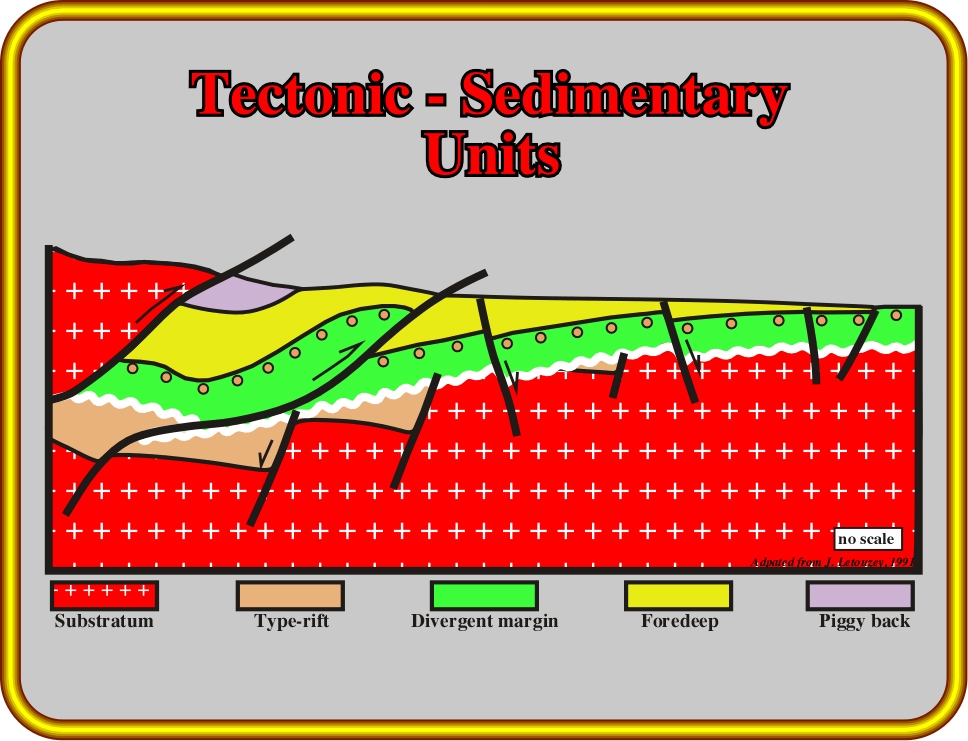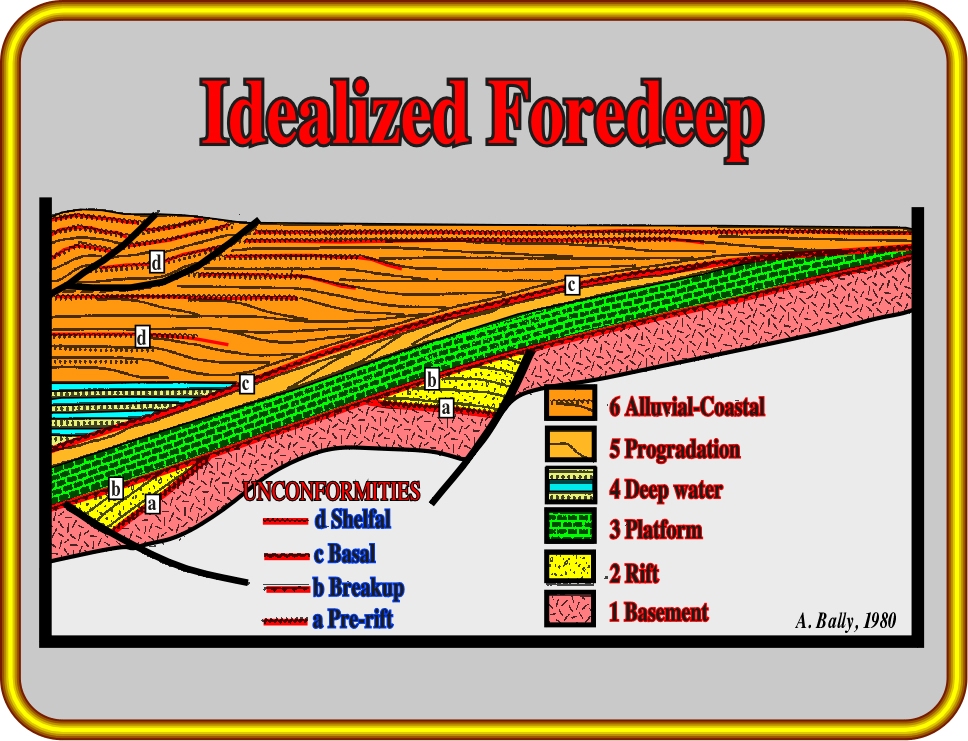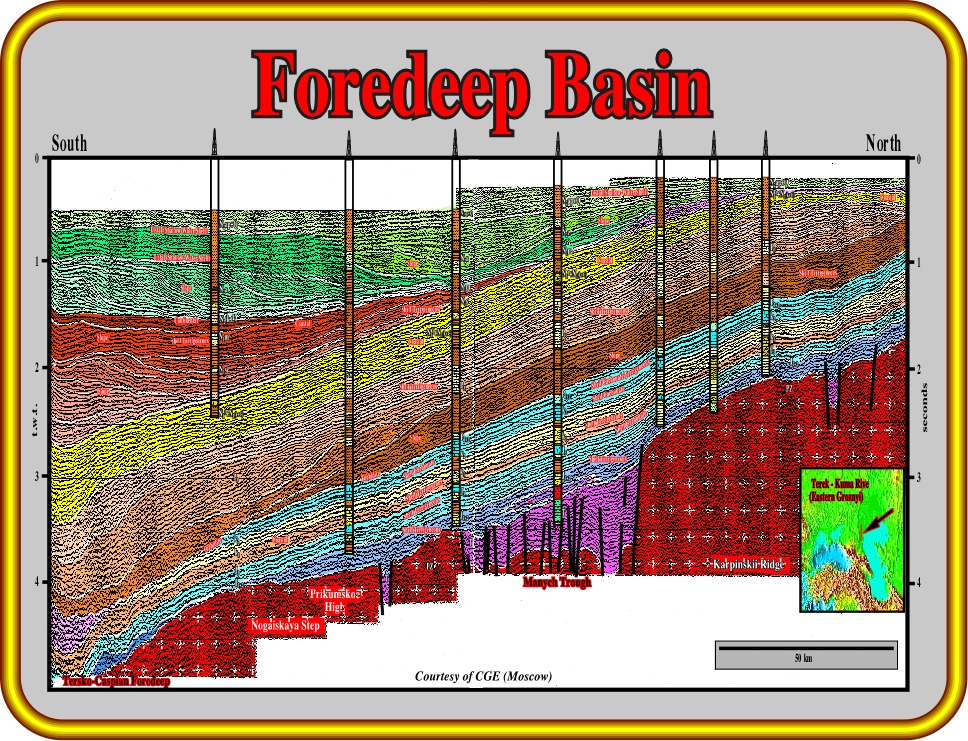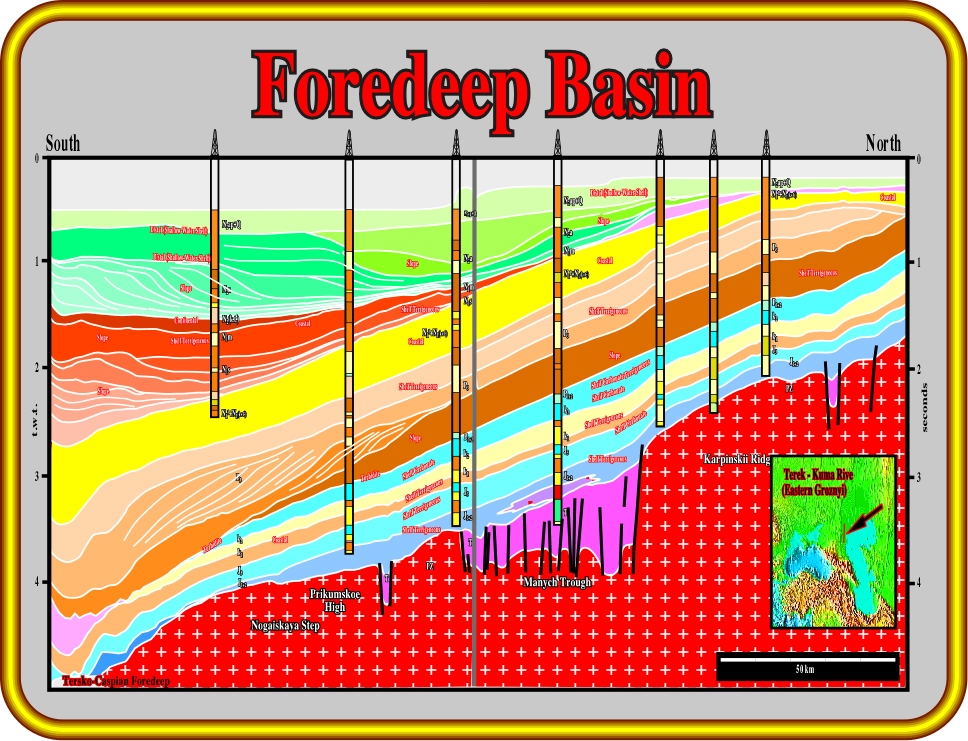III- Tectonic-Sedimentary Units
Theoretically, several tectonic-sedimentary units can be considered in foredeep basins. In the example illustrated in fig. 1, without taking into account the folded belt on the left, which has induced the flexural subsidence that characterizes the foredeep basin, it is easy to recognize the stacking of five different sedimentary basins. From bottom to top:
a) The substratum
The substratum is,, often a folded belt composed by sediments belonging to a previous continental encroachment cycle. However, in certain geological settings, it can be a metamorphic or a granitic craton, or an oceanic crust.

Fig. 1- In this sketch several sedimentary basins are stacked: (i) A substratum, which is composed, very often, of a fold-belt, (ii) several rift-type basins, (iii) a divergent margin, (iv) a foredeep basin and (v) a transported basin (“piggy-back). The divergent margin is bounded by two unconformities. The lower one emphasizes the top of the rift-type basins, i.e., the end of the lengthening of super-continent in which the rift-type basins are included, and the upper one underlies the beginning of the flexural subsidence (onset of foredeep basin).
b) Several rift-type basins
The lengthening of the lithosphere and, particularly, of the continental crust create these sedimentary rift-type basins. When lengthening is big enough, it can breakup the lithosphere individualizing two lithospheric plates and the associated divergent margins.
c) A divergent continental marginal (5)
The divergent margin is associated with the thermal subsidence following the breakup of the lithosphere. Generally, Atlantic-type divergent margins are composed by two stratigraphic phases. At the base: a transgressive or backstepping phase, with a global retrogradational geometry and, at the top, a regressive or forestepping phase, which has a strong progradational geometry.
(5) The presence of rift-type basins and particularly divergent margins is quite frequent when the foredeep basins results from the closing of an ocean. Depending on the geological setting, the divergent margins can be replaced by back-arc basin, Mediterranean basin, etc.
d) A foredeep basin
The foredeep basin is associated with a flexural subsidence (6). It is located outward of the frontal thrust. As the orogenic system progresses toward the divergent margin (landward), different foredeep basins will be stacked. In fig. 1, for simplicity, just one foredeep basin was drawn.
(6) We will study, mainly, foredeep basin created by A-type subductions (Ampferer-type). Those associated with B-type subductions (Benioff-type) have not significant hydrocarbon potential (Ex: Colombia offshore)
e) A “piggy-back” basin
“Piggy back” basins are localized inward of the fontal thrusts. In an orogenic belt in sequence, where the age of the thrusts is younger outward of the fold belt, “piggy-back” basins are coeval of the emplacement of the frontal ramp and associated foredeep basin.
These different tectonic-sedimentary units are bounded by unconformities, more or less, tectonically enhanced. Their origins are quite different as illustrated in the geological model idealized by A. Bally (fig. 2).

Fig. 2- This sketch illustrates features that are common to many foredeep basins. Four basically different unconformity types are recognized: (a) Pre-rift unconformity, (b) Breakup unconformity, (c) Basal foredeep unconformity, and (d) Shelfal unconformities. Each foredeep has its own individual development, which is accentuated by one or another feature of this idealized diagram.
The four major unconformities found in foredeep basins illustrated on fig. 2 are:
a) Pre-rifting uncinformity (a)
It marks the onset of the lengthening of the lithosphere, which can end with creation of a divergent margin.b) Breakup unconformity (b)
This unconformity marks the end of the rifting phase (lengthening of the lithosphere). It announces the onset of the sea floor spreading and a marine transgression. This unconformity pre-dates the creation of foredeep basin. Within the pre-foredeep stratigraphic sections, there are numerous unconformities associated with relative sea level falls with a predominant eustatic component.
c) Basal unconformity (c)
In the proximal area, i.e., near the fold belt, onlapping of foredeep deep marine sediments against tilted margin sediments characterize this unconformity. In the distal area, this unconformity is, mainly, characterized by toplapping of the shallow water sediments of the margin (7). In the distal area, the progradation of the foredeep sediments, preserving the erosional surface is, often, very subtle. The angle of the slope is too small.
(7) Toplaps are the consequence of the outward migration of the bulge anomaly.
Very often, immediately overlying this unconformity, there is a complex downlap surface marking the distal terminations of the progradation of the foredeep sediments.
d) Foredeep basin unconformity (d)
The majority of these unconformities are associated with relative sea level falls in which the eustatic factor is predominant. When these unconformities erode anticlines synchronous with the sedimentation, they are, locally, tectonically enhanced.


Fig. 3- On this tentative interpretation of an auto-trace of a seismic line from Tersko Caspian Foredeep, it is, easy, to recognize the main charcateristics of a foredeep basin, which overly a divergent margin, which overlies several rift-type basins. The four basically different unconformity types: (a) Pre-rift unconformity, (b) Breakup unconformity, (c) Basal foredeep unconformity, and (d) Shelfal unconformities are, readily, recognized.
The origin of these unconformities raises important problems in Sequential Stratigraphy (see short-course: "Seismic-Sequential Interpretation") and in the hierarchy of the stratigraphic cycles. Inn sequential stratigraphy an unconformity is an erosional surface induced, mainly, by a relative sea level fall. However, or a certain number of discordances (lack of parallelism between adjacent strata), as those mentioned below, the eustatic component seems insignificant, i.e. eustacy seems not to be the major geologic cause of the unconformities:
- The discordances characterized by erosion and truncation of the tilted fault blocks.
- The discordances induced by deepwater currents on the slope.
- The discordances associated with canyons on the divergent margins.
- The discordances seen in on shallow water environments induced by geostrophic currents (8).
(8) Geostrophic currents are atmospheric or oceanic currents in which the force of horizontal pressure is balanced (equal, but opposite) by the Coriolis force. They are not either accelerated or affected by friction.
- The discordances associated with starved basins.
- The discordances underlying the onset of seafloor spreading.
- The basal foredeep discordances.
- The discordances associated with the relaxation of the foredeep basins.
- The discordances associated with salt flowages, etc.
Send E-mails to carloscramez@gmail.com or to carlos.cramez@bluewin.ch with comments and suggestions to improve site.
Copyright © 2003 Ccramez, Switzerland
Last updated: August, 2014